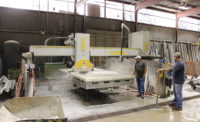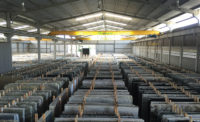Up until the mid-2000s or so, publishing the data -- and comparing it to previous years -- was an extremely gratifying exercise. As we all know by now, the value of stone imports to the U.S. had been growing at an explosive rate -- reaching a record high in 2006, when $3.36 billion worth of stone came into America.
This total dipped slightly in 2007, and then the freefall began as our industry hit rock bottom in 2009, when stone imports into the U.S. dropped down to $1.404 billion. (You aren't reading that wrong; stone imports to the U.S. in 2009 were really less than half of what they were just three years earlier. They declined 58.2%, to be exact.)
The good news is that when you fall that far, there really is nowhere to go other than upward, and that is exactly what happened in 2010. I'm not so sure that it is time to break out the Cuban cigars and Johnny Walker Blue yet -- at least the fabricators I have visited are not doing so -- but for the most part, the recovery of the stone industry has begun, at least from a statistical perspective. A full country-by-country listing of the 2010 import -- and export -- totals can be found on pages 28 to 31 of the print edition of Stone World, but here are some highlights:
• Overall, U.S. stone imports grew to a grand total of $1.553 billion in 2010, a rise of about 10.6% over 2009.
• Granite imports to the U.S. in 2010 reached a total value of $905.3 million, up 25.1% over 2009's total of $723.63. This total seems to reflect a recovery (relatively speaking) in the kitchen countertop market.
• Marble imports actually declined a bit -- dropping from a value of $568.425 million to $543.003 million (around 4.4%). This can be attributed -- at least in part -- to the still-stagnant commercial market, which consumes much of the marble brought into the U.S.
• The value of slate imports hardly changed at all in 2010, rising less than 1% over the previous year and reaching a total of $63.279 million.
• Imports of materials classified as "other" -- sandstone, dolomite, porphyry and not otherwise specified -- rose 18.2% last year, reaching a total of $49.145 million.
Looking at how some of the leading granite-producing nations performed in 2010 as compared to 2009, Brazil's export total rose a solid 44.8% to $407.987 million; India's total rose 39.2% to $124.662 million; and Italy saw a 16.6% jump to 118.804 million.
It is noteworthy that the value of granite exported from China to the U.S. actually declined around 1%, reaching a totaling of $191.065 million, even though the actual tonnage figure of 329,507 is a 19.1% increase over 2009. One interpretation of this trend is that even as the Chinese stone industry is lowering its prices, more American consumers are willing to pay for the exotic materials coming from markets such as Brazil, India and Italy.
In the marble sector, the only noteworthy gains (in terms of dollar value exported to the U.S.) were seen by Turkey (up 6.4% to $218.806 million) and Mexico (up 10.2% to $59.16 million). It should be noted that U.S. Customs classifies limestone and travertine products under the general category of "marble," and those materials are reflected in these figures above.
Of course, stone distributors pointed out to me that we cannot simply look at the increased import values and then say, "OK, the stone market has improved by 'X' percent." They pointed out that profit margins are still well below what they used to be, and that there are plenty of operations out there selling on the basis of price -- whether they are in fabrication or distribution.
Moreover, one distributor explained to me that even though some fabricators finally spent some money on inventory during the latter half of 2010, they might be done with large material purchases for a few months now that they have restocked their warehouses. Many shops are still buying slabs on an as-needed basis.
So there is the U.S. 2010 stone import market in a nutshell. Conclusion: The industry seems to be rebounding, but it is a slow ride for many.
We at Stone World are always interested in hearing specific insight from industry members, so if you want to share how your company is riding out the downturn, feel free to e-mail me at michael@stoneworld.com


